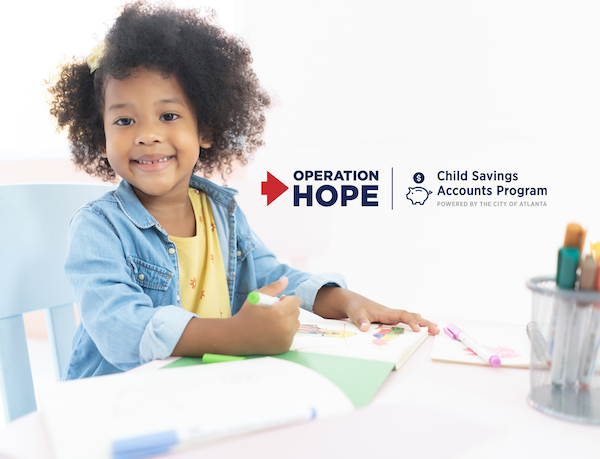Medora Lee | USA TODAY |
- College savings are more than just money to pay for college, it’s also a motivator, studies show.
- That’s why cities nationwide are investing public funds to seed college funds for kindergarteners.
- The savings accounts ignite conversations from a young age about college and helps youth aspire to attend.
Even at the tender age of five, Kasey-Jay is already dreaming of going to a place called Howard University.
How does a five-year-old even know about Howard University?
Because she’s in a college savings program based on studies showing that just merely having a college savings account – no matter how much was in it – resulted in more children going to college.
Kasey-Jay’s one of the first kids in the HOPE Child Savings Account Program in Atlanta that launched in May. The account’s unlikely to grow large enough to cover all college costs (which easily can run into the tens of thousands of dollars over four years), but importantly, it prompts regular conversations about college.
Kasey-Jay often talks with her mom Jatisha McCoy, about what the account means, how much is in it, and what it’s going to be used for.
The HOPE program is one of many that have emerged across the country in the last decade based on the studies.
What’s the data behind the theory?
A child with a college savings account, no matter the dollar amount in it, is 6 times more likely to go to college, according to a Center for Social Development study. They are also 4 times more likely to graduate.
That’s because psychological benefits are associated with having a college fund. Just having the fund establishes a belief that college is possible and an expectation that the child is going to college.

“It didn’t matter if a family was low income, or the amount saved was a lot or very little,” San Francisco Treasurer Jose Cisneros said. “It just spurred dialogue that built aspirations in a child, and that was enough to improve outcomes.”
To policy makers in San Francisco 11 years ago, this was compelling evidence that the positive effect of savings were more than economic and was the catalyst for Kindergarten to College (K2C). Since then, the idea has continued to blossom across the country with Atlanta as the latest city to launch such a program.
To policy makers in San Francisco, this was compelling evidence that the positive effect of savings may be more than economic. They changed the college expectations of parents and children, and it wasn’t income but assets that was associated with college success.
Kindergarten to College was born
K2C started in 2011 with each public-school child entering kindergarten automatically receiving a college savings account seeded with $50 from public funds. Throughout the years between kindergarten to college, families can grow the account by making deposits or capitalizing on incentives such as winning matching funds or bonus deposits.
The point of the program was not only to help families start saving for college, but to start young kids knowing about and aspiring to college.
“It’s putting young people on the path to stronger educational outcomes,” said Brandee McHale, head of Community Investing and Development at Citi and president of the Citi Foundation, whose company participated in that pilot program. “It’s how to change the conversation in first generation families so it’s not if you go to college, but when you go to college. It’s building a college-going identity.”
Proven success
Success of the program hinged on making it easy and accessible to families, which is why San Francisco chose Citibank to help it in its launch more than a decade ago.
Citibank had a lot of branches around the city that made it easy for families to walk into a branch and make a deposit. In some branches, families were able to drop deposits in a big drop box, making these events family occasions. The funds are held at Citibank and can’t be withdrawn until high school graduation. If you move, there’s a way to take the funds with you.
“Initially, I really didn’t pay much mind to it.” said Aisha Brown, whose daughter Tierra was in the first K2College class in San Francisco and is preparing soon to apply for colleges. “But more recently, a lightbulb went off because college is here and what are we going to do?”
That’s when she remembered the account Tierra had received when she started kindergarten, and she started paying more attention. She and her daughter started taking advantage of contests and incentives to boost her account.
“My daughter got $500 for a contest based on themes,” for example, Brown said. She said Tierra’s account is now more than $900.
PRIORITIES: I’m prioritizing my retirement savings over my son’s college fund. Here’s why.
FINDING SAVINGS: Fintechs launch crypto, cash-back rewards for college to help parents save for their kids
Aisha said, “if I were more engaged, think of where we could be,” but she’s still thankful for the account. It’s given her the opportunity to talk to her daughter about college, what she wants to study (she wants to be a pediatric nurse) and how to spend the money saved.
“We’re hoping to have at least $1,500 by the end of 12th grade, and maybe it can go towards applications or books,” she said.
The program’s growing up and growing out
San Francisco’s K2C program now boasts more than 49,000 accounts, with more than $11 million saved in total.
“Of that, two-thirds has been deposited by families at a rate of 2 to 1 versus what the city has put in,” Cisneros said. More importantly, “there have been millions of conversations about college and that’s leading to success.”
What’s more, this model has been replicated across the country, with 123 active college savings accounts programs reaching more than 1.2 million children in 39 states, the San Francisco Treasurer’s office said in late April.
Since then, Atlanta launched its HOPE program. It works similarly to San Francisco, but it has incorporated financial literacy workshops for students, parents, and caregivers given by experts at Operation HOPE, a nonprofit providing financial literacy and economic education to youth and adults.
“Communities that aren’t taught financial literacy is why they’re left behind,” John Hope Bryant, founder and CEO of Operation Hope, the partner in the program that holds the savings in custodial accounts at Citibank. “We start in kindergarten when minds are molding.”
CHOICES: Middle class, minus debt: Apprenticeships, certificates offer low-cost option to college
SCHOLARLY TIPS: Pennsylvania teen shares advice after receiving $1.8 million in scholarships, 57 college offers
Though it’s early to tell for sure of the success Atlanta will have, it seems at least to be igniting early discussions of college. Kasey-Jay not only knows about Howard University but also knows she must save some of her birthday money each year to pay for it.
“She can bring her coins and put them in the coin machine, so it’s cool for the kids,” McCoy said. “She gets so excited because she thinks she’s a big girl, and she’s learning about banks and how to save money.”
Kasey-Jay also often talks with her mom about life beyond college. She says she wants to be an entrepreneur with her own store.
“She wants to be the boss,” McCoy said.
Medora Lee is a money, markets, and personal finance reporter at USA TODAY. You can reach her at mjlee@usatoday.com and subscribe to our free Daily Money newsletter for personal finance tips and business news every Monday through Friday morning.
